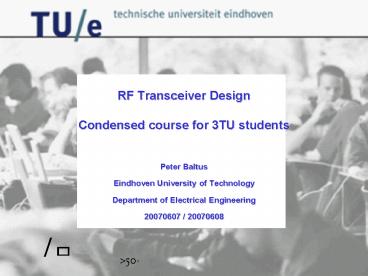RF Transceiver Design Condensed course for 3TU students - PowerPoint PPT Presentation
1 / 34
Title: RF Transceiver Design Condensed course for 3TU students
1
RF Transceiver DesignCondensed course for 3TU
students
- Peter Baltus
- Eindhoven University of Technology
- Department of Electrical Engineering
- 20070607 / 20070608
2
Agenda Day 1 Thursday June 7th 2007
- 1000-1115 lecture 1
- Systems, specs
- Technologies FOMS
- Architectures finding subblock parameters
- 1115-1200 instruction 1
- 1200-1300 lunch
- 1300-1415 lecture 2
- Amplifiers Mixers
- 1415-1530 instruction 2
- 1530-1630 lecture 3
- Oscillators Filters
- 1630-1700 instruction 3
3
Agenda Day 2 Friday June 8th 2007
- 900-1015 lecture 4
- Block interaction
- substrate xtalk
- coupling of inductors
- Packaging
- thermal effects
- multi-mode
- non-linear input/output impedance
- 1015-1100 instruction 4
- 1100-1200 lecture 5
- Multiple-antenna OFDM systems overview, system
build-up, digital signal processing - 1200-1300 lunch
- 1300-1400 lecture 6
- Influence and digital compensation of Phase Noise
and Carrier frequency offset - 1400-1430 instruction
- 1430-1530 lecture 7
- Influence and digital compensation of IQ
imbalance and nonlinearities, generalized error
model - 1530-1600 instruction
4
Lecture 1 RF Systems Specifications
5
Instruction
6
Question 1
- Design a simple mass-market WLAN system
- - f 5..6GHz - BW 20MHz
- - SNRmin 11dB
- - Range 100m LOS
- Find a consistent (but not unique) set of
parameters - - Transmit power
- - Receive noise figure
- - Receiver IP3
- - Receiver selectivity
- Make any reasonable assumption required
7
Question
- Calculate required transmit power if
- Frequency 2.5GHz
- range 10m
- sensitivity -70dBm
- omnidirectional antennas
- LOS
8
Solution
- PRX-70dBm
- GRX GTX0dB
- Wavelength0.12m
- PTX 0.11mW
- Low power!
- Cheap AA NiCd battery 1.5Wh gt 14000 hr!
9
Question
-10 dBm
Pout
-40 dBm
frequency
2
What is IIP2 and OIP2 assuming a power gain of 7
dB
10
Two signals at the input of a non-linear system
Yield a lot! of other frequency components
?1
?2
11
A forest of frequencies
12
Graphical overview of inter-modulation products
13
Calculation of IP2
IIP2 input power where wanted power second
order power (extrapolated point).
14
Formula for OIP2 (small signal extrapolation!)
Pfund,out
Pout
?P
frequency
2
(dBm)
15
Answer
The input IIP2 is OIP2 divided by the power gain
(so -7 dB)
16
Calculation of IP3
IIP3 input power where wanted power the third
order power(extrapolated point).
17
Formula for OIP3 (when not in compression)
Pfund,out
Pout
?P
freq.
2
(dBm)
18
RX NF
- Exercise
- Calculate RX minimum NF for
- Psensitivity -70dBm
- BW 20MHz
- SNRmin15dB
19
RX NF
- Solution
- PRX-70dBm
- BW20MHz
- SNRmin 15dB
- Equivalent input noise -85dBm
- Equivalent input noise density-158dBm/Hz
- Thermal noise density (kT) -174dBm/Hz
- Total transceiver NF16dB
- Note need to include losses for antenna filter,
switches, antenna loss (total e.g. 3dB) and
baseband implementation loss to get RX IC NF
20
RX ADC
- Exercise
- Bandwidth 1MHz
- max signal -20dBm
- min signal -70dBm
- SNRmin 11dB
- Calculate ADC minimum sampling rate minimum
bits assuming perfect analog channel selectivity
but no AGC, and ADC noise contribution less than
1dB
21
RX ADC
- Solution
- Bandwidth 1MHz, sample rate gt2Msps
- Resolution
- max signal -20dBm
- min signal -70dBm
- equivalent input noise -81dBm
- equivalent ADC input noise -91dBm
- Dyn range 71dB
- Effective resolution gt 12bit
22
Lecture 2 Amplifiers Mixers
23
Instruction
24
Question 1
- For a simple mass-market WLAN system
- - select a (very simple) LNA topology
- - identify main performance parameters
- - choose typical/common sense values
- - set approximate values for components
- - draw an approximate layout of the IC
- - identify potentially relevant parasitic
elements
25
Question 2
- For a simple mass-market WLAN system
- - select a (very simple) Mixer topology
- - identify main performance parameters
- - choose typical/common sense values
- - set approximate values for components
- - draw an approximate layout of the IC
- - identify potentially relevant parasitic
elements
26
Lecture 3 VCOs and Filters
27
Instruction
28
Question 1
- For a simple mass-market WLAN system
- - select a (very simple) VCO topology
- - identify main performance parameters
- - choose typical/common sense values
- - set approximate values for components
- - draw an approximate layout of the IC
- - identify potentially relevant parasitic
elements
29
Question 2
- For a simple mass-market WLAN system
- - select a (very simple) IF filter topology
- - identify main performance parameters
- - choose typical/common sense values
- - set approximate values for components
- - draw an approximate layout of the IC
- - identify potentially relevant parasitic
elements
30
The End
- for today!
- Thanks for your attention !
- Tomorrow
- Block interaction
- or
- Why it still doesnt work ?
31
Lecture 4 Why it still doesnt work ?
32
Instruction
33
Question
- Design
- Floorplan
- Pin-out
- For a 4x4 MIMO WLAN transceiver for the
mass-market
34
The End
- for my contribution today
- Thanks for your attention !































